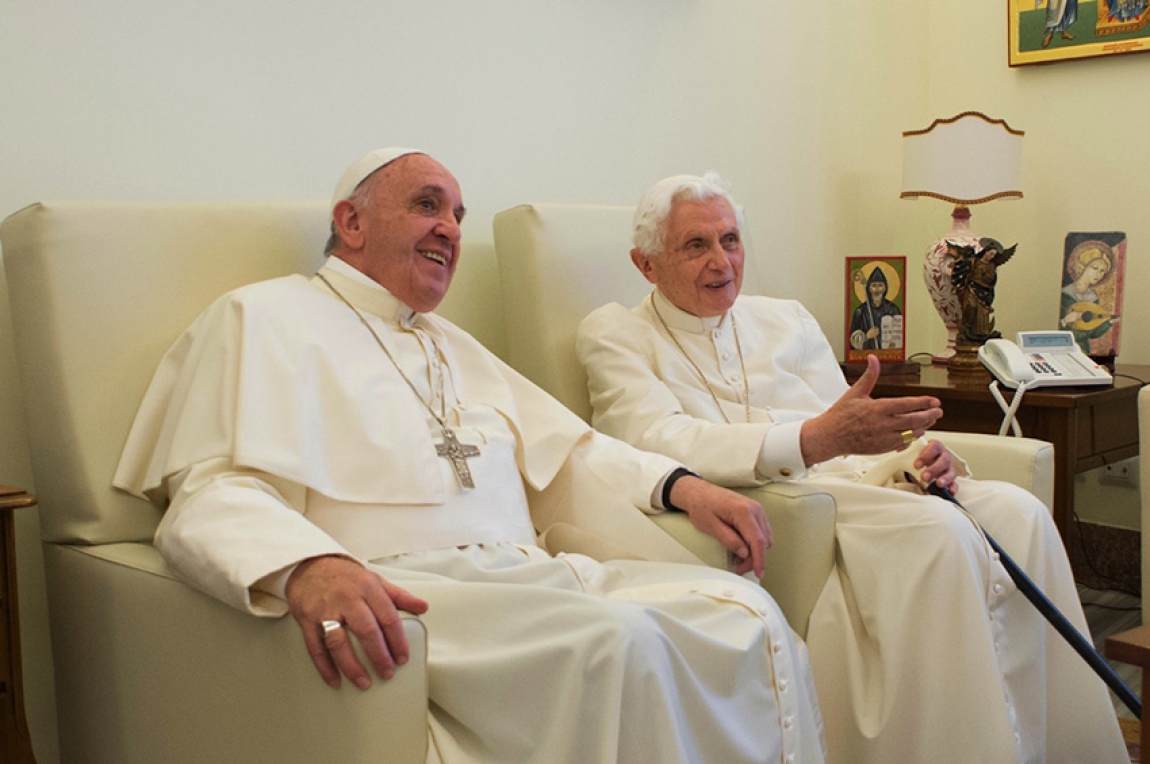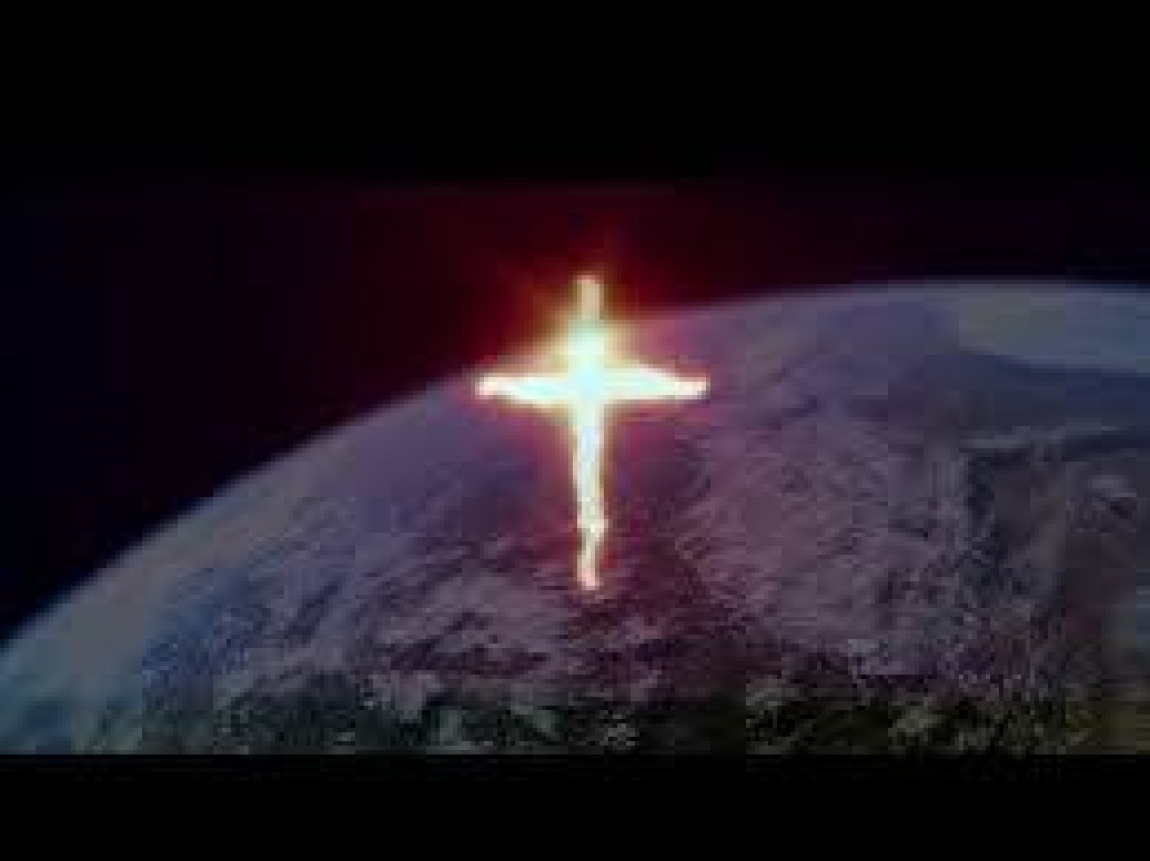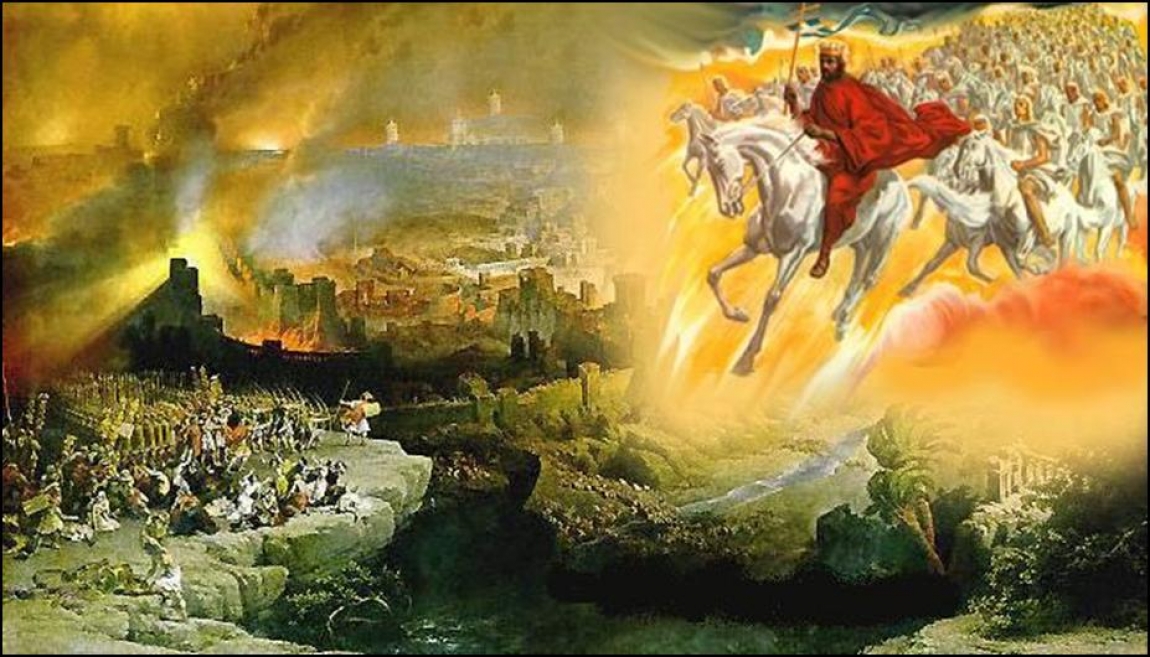Among the references which stand out most regarding the Antichrist, whom St. Paul also called the “Impious one”, the “lawless one”, the “son of perdition”, the “adversary”, there is an element which shows us at what moment he will make his appearance on the world stage, because it precedes him and is directly related to him.
This sign is found in the second letter that the Apostle wrote to the Christian community of Thessalonica, following his pastoral visit to that city. In this document, St Paul establishes that before the Antichrist manifests himself publicly a person who “restrains” or holds back this manifestation must be taken out of the way:
“Let no man deceive you by any means, for unless there come a revolt first, and the man of sin be revealed, the son of perdition, Who opposeth, and is lifted up above all that is called God, or that is worshipped, so that he sitteth in the temple of God, shewing himself as if he were God. Remember you not, that when I was yet with you, I told you these things? And now you know what witholdeth, that he may be revealed in his time. For the mystery of iniquity already worketh; only that he who now holdeth, do hold, until he be taken out of the way. And then that wicked one shall be revealed whom the Lord Jesus shall kill with the spirit of his mouth; and shall destroy with the brightness of his coming” (2 Thess 2, 3-8).
The purpose of the Letter was to foment hope in the midst of trials, but also to moderate the fervour of the Thessalonians. St. Paul had preached in Thessalonica with so much passion about the mystery of iniquity, that the Thessalonians believed the end times were already imminent. For this reason, Saint Paul lets them know about the existence of an “obstacle” (in Greek katejon) which must first be removed, so that the Antichrist can then manifest publicly.
In verse 6 he uses the present participle with a neuter pronoun (to katejon) “You know what it is that now restrains him”. In verse 7 he uses it with the personal pronoun (ho katejon) “Once he who restrains him is taken out of the way, then the impious one will show himself”.
A careful reading of the Pauline text will bring us to the conclusion that the Apostle deliberately used two different pronouns to differentiate differing realities: the neuter meaning to designate a reality of impiety and apostasy which was already acting from that time and with which the disciples were perfectly familiar (but which would reach its height at the end times of the Church), and the masculine meaning, referring to a concrete person, whose identity has been a mystery for many throughout the history of the Church and which will be the cause that delays the public manifestation of the impious one, until he be removed.
In this way, the katejon cannot be taken in its neuter sense, as if it were an institution, or a state of things, or a movement favourable to Christianity. The immediate prior reference of St. Paul referring to apostasy and impiety in verse 6 poses serious difficulties for this interpretation, since the Apostle would have used the same words in the verse that followed.
Because of this, and because St. Paul also refers to the Antichrist in the sense of a concrete and precise person, one can conclude that “the restrainer” is necessarily a physical person, and its meaning must be taken in the masculine sense.
The full meaning of verse 7 seems to indicate that St. Paul sets one person, the Antichrist, against another person, precisely against the one who delays or obstructs his public appearance. In other words we find ourselves between a human concrete person and one who is not historic but in the future.
Outwardly what St. Paul tells us does not give us sufficient elements to conclude who he is referring to. Nevertheless, a thorough reflection on the text helps us to find two hints that point to his identity.
The first one, as we have already said, he must necessarily be somebody contemporaneous, as he delays the public appearance of the Antichrist and has some direct relationship with the “impious” one, and for this reason it cannot refer to an historical person in history.
Secondly, this relationship is situated on a spiritual plane, as the manifestation of the “impious one” is linked to apostasy, the abandoning or denial of the true religion, in favour of the global “unification” of all religions. In other words, the restrainer is a religious leader whose efforts avoid or delay the apostate doctrine becoming dominant.
Let us analyse the text again: “...“Let no man deceive you by any means, for unless there come a revolt first, and the man of sin be revealed (...) only that he who now holdeth, do hold, until he be taken out of the way. And then that wicked one shall be revealed...”
With these two elements, and given that Jesus Christ promised the special assistance of the Holy Spirit to one person only, to St. Peter and his legitimate successors, to guarantee the preservation of the deposit of Faith, against the different forms of apostasy, one could conclude that the “restrainer” will be the reigning pope when doctrinal dissolution reaches such a level that the Antichrist can fool and fascinate the world.
Another important consideration is that to be taken out of the way is not synonymous with being dead. Something as serious as that would have been pointed out by St. Paul with total clarity. Here we are talking about to be removed, excluded, separated from the post or the place from which one exercises the function that precisely delays the public appearance of the Antichrist, either by means of the action he exercises, or by means of the function he plays, or both.
This reality makes one wonder if the Pauline prophecy of katejon could be the prediction and the scriptural basis of the revelation that Pope St. Pius X and other Catholic mystics had, who speak of a violent persecution that awaits a Pope, and that an antipope takes at that moment the physical place of his Seat.
In 1909, Pope St. Pius X confided to his private secretary and other close ecclesiastics a very special revelation: “I had a terrible vision: I don’t know if it is I or one of my successors, but I saw a Pope fleeing from Rome among the corpses of his brothers. Incognito, he will take refuge somewhere and after a short time he will die a cruel death”.
This event, which hasn’t happened yet, coincides almost literally with the content of the vision the children of Fatima had in 1917. The Blessed Virgin showed them the scene of a bishop dressed in white, fleeing a city in ruins, over the corpses of many priests and lay people, to be killed later.
The first thing we notice is that this has not occurred, and that it does not refer, as the Vatican tried to make us believe on the 26th of June 2000, to the attempt on the life of John Paul II in 1981, since the Pope didn’t flee Rome, that city was not in ruins, there were no corpses of priests and lay people on the way, and he wasn’t killed later.
On the other hand, a growing number of serious and documented investigations show that the third secret of Fatima in reality is made up of two different documents: the pages that Sister Lucy wrote with the vision of the bishop dressed in white who is fleeing from a city in ruins, and another, consistent with a piece of paper in which she wrote the words of the Blessed Virgin with which she explained the meaning of the vision.
The story is simple. Sister Lucy fell gravely ill in June 1943. Her superior, Monsignor Da Silva, Bishop of Leiria-Fatima, fearing that she could die of her illness, ordered her on the 15th of September, to write the Secret of Fatima. The Sister asked him to give her a formal written order. When she received it, she experienced a strange paralysis which she considered of supernatural origin. Finally, on the 2nd of January 1944, the Virgin Mary herself appeared to her confirming that this was the will of God, and that She would give her the necessary strength and light to be able to write it down, which she did the following day. Nevertheless, her declining health was so severe that Sister Lucy could only write the vision in her diary, but not the words of the Virgin that interpret the vision.
It wasn’t until the 9th of January that Sister Lucy had the strength again and finally wrote the words of the Virgin on one page. This happened in the chapel of the convent in Tuy.
What the Vatican made known on the 26th of June 2000 was the first document, that of the vision, but they did not make known the document which has the interpretation.
Different witnesses confirm the existence of the document which was not made known, these include Cardinal Ottaviani, Monsignor Cappovilla, private secretary of Pope John XXIII.
The different dates in which each of the two documents arrived at the Vatican are known, where each one is kept, and the dates the Popes read them. All this contemporary history has been reported in different recent works like that of Andrea Tornielli (il segreto svelato, italia, 2000); the Vatican expert Marco Tossati (il segreto nos svelato, italia, 2002), that of Solideo Paolini (Fatima, non Disprezate le Profezie, Italia, 2005), that of Antonio Socci (il Quarto Segreto di Fatima, Italia, 2006) and that of Luis Eduardo Lopez Padilla (Dos Papas en Roma, Mexico, 2007). In spite of all this evidence the Vatican continues to deny the existence of the second document, preferring not to make known the words of the Virgin. Only the first document, that of the vision, was made known.
In all, thanks to the concordances and the various testimonies pointed out above it is possible to conclude that the second document speaks of a time of great trial for the Catholic Church and the West, in which there will be serious opposition of cardinals against cardinals, bishops against bishops, lay people against lay people, fruit of a schism in which the legitimate Pope will have to flee Rome and take refuge, while an antipope will take charge of leading the “new church” and spreading the apostasy from the very seat of Rome.
In the words of Cardinal Luigi Ciappi, personal theologian to Pope John Paul II: “The Third Secret refers to the loss of Faith in the Church, i.e. the apostasy, which will come out from the top of the Church”.
In the words of Fr. Paul Kramer, “The antipope and his collaborators will be apostates, as Sister Lucy said, followers of the devil, they will work for evil and will fear nothing”.
This is not something new. In the history of the Church there have been 38 antipopes, Jorge Mario Bergoglio included, i.e. ecclesiastics elected illegitimately while the legitimate Pope was still alive. The seriousness of this schism is that the content will be eminently doctrinal and against the Faith. This will be the opposition between the new Church and the Church of Tradition, the Church adapted to the world and the faithful Church.
Of course, the revelation of Fatima does not have an infallible character and of faith, as the public prophecy of St. Paul on the katejon has, but Fatima is one of the few Marian revelations, of the greatest credibility, accepted by the Church, be it for the cosmic sign that happened on the 13th of October 1917, or for the fulfilment of a part of the prophecy which has already been verified, or be it, especially, for its spiritual fruits and conversions.
Besides Fatima, we find other private revelations that coincide with the said prophecy:
The most important and best known is that of St. Francis of Assisi: “There will be an uncanonically elected Pope who will cause a great schism. Different ways of thinking will be preached which will cause many to doubt, even those in different religious orders, even being in agreement with those heretics who will cause my order to be divided. Then there will be such dissensions and persecutions at a universal level that if those days weren’t shortened even the elect would be lost”.
But we also have the words of Juan de Vitiguero, in the XIII century: “When the world is disordered, the Pope will change residence”.
From Juan de Rocapartida, a century later: “As we approach the end times, the Pope and his cardinals will have to flee Rome in tragic circumstances to a place where they will remain unknown, and the Pope will suffer a cruel death in exile”.
Nicolas de Fluh, in the XV century: “The Pope and his cardinals will have to flee Rome in a calamitous situation to a place where they will be unknown. The Pope will die in an atrocious way during his exile. The sufferings of the Church will be greater than any previous time in history”.
The Venerable Bartolome Holzhauser, founder of the societies of secular clerics in the XVIII century: “God will allow great evil to be done to His Church: they will come quickly and unexpectedly bursting in while the Bishops and priests are asleep. They will enter Italy and devastate Rome, they will burn Churches and destroy everything”.
The words of the Virgin revealed in La Salette to Melanie: “Rome will lose the Faith and become the seat of the Antichrist”.
The revelation received by Mother Elena Aiello, a famous stigmatic frequently consulted by Pope Pius XII: “Italy will be shaken by a great revolution (...) Russia will impose itself on the nations, in a special way over Italy, and it will raise the red flag over the dome of St. Peter’s”.
Blessed Ann Catherine Emmerick, an Augustinian religious, in 1820: “I saw strong opposition between two Popes, and I saw how disastrous the consequences of the false Church would be, I saw that the Church of Peter would be rocked by the plan of a sect. When the reign of the Antichrist is near, a false religion will appear which will be against the unity of God and of His Church. This will cause the greatest schism which will ever have been seen in the world”.
Elena Leonardi, spiritual assistant to Padre Pio: “The Vatican will be invaded by communist revolutionaries. They will betray the Pope. Italy will suffer a great revolt and it will be purified by a great revolution. Russia will march on Rome and the Pope will be in grave danger”.
Enzo Alocci: “The Pope will disappear temporarily and this will happen when there is a revolution in Italy”.
Blessed Anna Maria Taigi: “Religion will be persecuted and the priests massacred. The Holy Father will be obliged to leave Rome”.
The mystic Maria Steiner: “The holy Church will be persecuted, Rome will be without a Shepherd”.
The revelations in Garabandal: “The Pope will not be able to stay in Rome. He will be persecuted and he will have to hide”.
Fr. Stefano Gobbi, mystic and founder of the Marian movement for priests: “The masonic forces have entered the Church in an underhand and hidden way, and they have established their headquarters in the same place where the Vicar of my Son lives and works. What is contained in the third part of my message is coming to pass, which still hasn’t been revealed, but which is already becoming obvious by the very events you are living”.
Jesus Christ related a part of the discourse of the last supper with the fact that, once he was arrested, His disciples would abandon Him. But, in a wider sense, Christ was quoting a prophecy from the Prophet Zechariah which refers to a shepherd of the end times, and which points out that only a third of mankind will survive the Great Tribulation. His words are: “I will strike the shepherd and the sheep will be scattered, and I will turn my hand against the little ones. And it will happen that in all the earth-it is the Lord who speaks- two thirds will be exterminated, and the other third will remain in it” (Zech 13, 7-8).
Here we find not only a parallel between the passion of the Master and that which the Church will have to suffer during the Day of the lord and the Great Tribulation, a period in which millions will perish, but also a warning for the reigning Pope immediately prior to the public manifestation of the Antichrist, letting him know that his person will be the object of an attack, with the intention of dispersing the sheep who are united to him, in order to go after those who are weakest in the faith afterwards.
Besides, the prophecy of Zechariah doesn’t say that the shepherd will be killed, as happened to Christ, but that he will be wounded. The difference between both situations is obvious, and it serves to distinguish what Christ suffered from what will happen the shepherd who is reigning, when the Day of the Lord and the Great Tribulation begin.
On the other hand, the specific context of the generalised apostasy indicates that the dispersion of the sheep must be more moral than physical. Besides, the wound must contain some element that can remove the katejon which holds back the public manifestation of the one who will benefit from the apostasy.
An additional element of the actions which wound the shepherd is that these permit the conspirators to control the ecclesiastical structure to facilitate the entry of the wolf. This hypothesis would find its fulfilment in the fact that the imposter could snatch the geographical place from the true shepherd, i.e. Rome, which would express the “abominable desolation” installed “where it should not be”.
The apostles knew the threat and they identified it with clarity, being conscious that the adversaries would enter among them like ferocious wolves: they came from among them but they weren’t of them, as St. John points out. Jesus Himself warns them that the darnel would grow among the corn, until the time of harvest came, when He Himself would have to separate them.
Contemplating that the apostasy is already running its course, that the Church has been infiltrated by illuminist satanic masonry to destroy it from within with a Christianity adapted to the world, and that high level ecclesiastics of this group carried out the monstrosity of murdering Pope John Paul I on the 28th of September 1978, and attempted on different occasions against the life of Pope John Paul II, it is highly probable that the katejon which must be removed for the Antichrist to reveal himself publicly is going to be a pope, one who doesn’t share their goals, and for that reason gets in their way.
To know about the murder of John Paul I at the hands of cardinals affiliated to ecclesiastical freemasonry, it is necessary to read the work of Bishop Jesus Lopez Saez, El Dia de la Cuenta, Ed. Mediterraneo, Madrid, 2002. Lopez Saez is founder of the community of Ayala, expert in John Paul I, member of the European Team of Catechumenate, head of the Pastoral Commission for adults in the National Catechetical Secretariat of Spain. Since 1985, Lopez Saez undertook an exhaustive investigation on the motives that led a group within the Vatican to murder the recently elected Pope. His work is, without any doubt, one of the most documented and revealing.
This circle of ecclesiastical masons in the seat of Peter will promote a Pope who will accept married priests, contraception, homosexual unions, the ordination of women, collegial authority of the Bishops, New Age spirituality, etc., etc.,...The majority of Catholics will be delighted that finally they have a Pope who understands modernity and is capable of adapting the Church to the world.
On the contrary, the faithful who keep Tradition taught by John Paul II and Benedict XVI will be ridiculed and persecuted.
The text of the second letter of St. Paul to the Thessalonians about the katejon could be the scriptural foundation of the private revelation which Lucia, Jacinta and Francisco received a little over ninety years ago, and which is confirmed by distinct private revelations, of which that of Pope St. Pius X stands out, in the sense that a destiny of a bloody persecution and a brutal death in captivity awaits a supreme Pontiff, and that this situation provokes the greatest schism in the Church.
The most serious of all is that this situation will be caused by the upper hierarchy in the Church who work for the enemy, and that they favour doing so as to put an imposter on the chair of Peter so as to more easily sway the faithful into accepting their modern teachings. This is precisely the “abomination of desolation” predicted by the Prophet Daniel, by St. John and by St. Paul.











